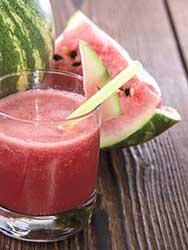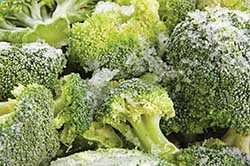Watermelon juice may reduce soreness; Bubbles influence bite; Defining ‘gluten-free’
NEWS
 Watermelon juice may reduce muscle soreness
Watermelon juice may reduce muscle sorenessAn amino acid found in watermelon may play a key role in helping to decrease post-exercise muscle soreness, according to a study published in Journal of Agricultural and Food Chemistry.
The antioxidant properties and potential to increase muscle protein and enhance athletic performance of watermelon juice have been addressed in research, but the researchers involved in the current study wanted to determine how effective watermelon juice drinks enriched with the amino acid L-citrulline were. They gave subjects natural watermelon juice, watermelon juice enriched with L-citrulline, or a control one hour before exercise. The results showed that subjects who consumed the natural juice or the enriched juice had relieved muscle soreness after exercise. The researchers noted that the L-citrulline in the natural juice that was unpasteurized appeared to be more bioavailable.
The study, “Watermelon Juice: Potential Functional Drink for Sore Muscle Relief in Athletes,” appeared in the Aug. 7, 2013, issue of Journal of Agricultural and Food Chemistry.
Bubbles influence carbonation bite
Bubbles are not directly responsible for the “bite” of carbonated beverages, report researchers from Monell Chemical Senses Center. They do, however, enhance the bite sensation beyond the chemical irritation caused by carbonic acid, which is formed from free carbon dioxide through an enzymatic reaction.
The researchers based one experiment on the fact that bubbles cannot form when atmospheric pressure is raised above a certain level. They seated the test subjects in a hyperbaric chamber where they rated the bite intensity of several concentrations of carbonated water. The subjects did this once while under normal atmospheric pressure (with bubbles) and once while under a higher pressure (no bubbles). They reported no difference in the bite intensity.
The second experiment examined the possibility that the bubbles could still contribute to the overall sensation of carbonation. Test subjects in a laboratory setting rated the bite intensity of carbonated water under normal conditions and when additional air bubbles were added to the liquid. The results showed that air bubbles enhanced the bite intensity of the carbonated bubbles, perhaps by stimulating the sense of touch, the researchers reported.
The study, “The Influence of Bubbles on the Perception Carbonation Bite,” appeared in the online public access journal PLOS ONE, doi: 10.1371/journal.pone.0071488.
FDA defines ‘gluten-free’
The U.S. Food and Drug Administration recently released a new regulation that defines the term “gluten-free” for voluntary use in food labeling. It gives manufacturers who label food products as gluten-free a uniform standard and can help people who follow a gluten-free diet.
Specifically, the regulation stipulates that food labeled “gluten-free,” “no gluten,” “free of gluten,” and “without gluten” must have a gluten content of less than 20 parts per million. Food manufacturers will have one year after the rule is published to make sure that their labels comply with the new regulation. For more information, visit https://www.federalregister.gov/articles/2013/08/05/2013-18813/food-labeling-gluten-free-labeling-of-foods.
Submit comments on proposed rules
The U.S. Food and Drug Administration has extended the comment periods on the proposed rules on preventive controls for human food and produce safety until Nov. 15, 2013. This is the second and final extension of the comment period for the proposed rules.
The FDA issued the extension to give interested people the chance to consider the interrelationships between the two proposals, Current Good Manufacturing Practice and Hazard Analysis and Risk-Based Preventive Controls for Human Food and Standards for the Growing, Harvesting, Packing, and Holding of Produce for Human Consumption, which were published on Jan. 16, 2013, and two proposed rules, Foreign Supplier Verification Programs for Importers of Food for Humans and Animals and Accreditation of Third-Party Auditors/Certification Bodies to Conduct Food Safety Audits and to Issue Certifications, which were published on July 29, 2013.
For more information, visit www.fda.gov/Food/NewsEvents/ConstituentUpdates/ucm364189.htm.
--- PAGE BREAK ---
 Boosting broccoli’s health benefits
Boosting broccoli’s health benefits
Two studies from researchers at the University of Illinois shed some light on frozen broccoli and how to improve the nutritional aspects of an important cancer-fighting phytochemical in the vegetable.
The first of the two studies found that the heat from blanching broccoli prior to freezing destroys the enzyme myrosinase, which is necessary to form the cancer-preventive compound sulforaphane. Despite this discouraging finding, the researchers did learn from the second study that there are steps the food industry could take to help improve the efficacy of myrosinase as a precursor to the development of sulforaphane. They found that blanching the broccoli at 76°C, a slightly lower temperature than the industry standard of 86°C, helped to preserve 82% of myrosinase without negatively affecting food quality and safety.
Another method to boost the health benefits was to sprinkle an amount of radish undetectable to the eye and taste buds on frozen broccoli. The myrosinase in the radish worked to form sulforaphane in the broccoli, which means that food processors could blanch and freeze broccoli and sprinkle it with the radish to produce a product that is even more healthful than before, explained Edward B. Dosz, a graduate student who works with lead researcher and professor of nutrition Elizabeth Jeffery. The benefits of this were evident even when the frozen broccoli was cooked for 10 minutes at 120°F in the microwave.
The study, “Commercially Produced Frozen Broccoli Lacks the Ability to Form Sulforaphane,” was published in the April 2013 issue of Journal of Functional Foods and the study, “Modifying the Processing and Handling of Frozen Broccoli for Increased Sulforaphane Formation,” was published online early in Journal of Food Science, doi: 10.1111/1750-3841.12221.
Understanding bitterness tolerance
Consumers who prefer solid dark chocolate have a tolerance for twice the amount of bitter ingredients in chocolate ice cream than those who prefer milk chocolate, according to a study published in Journal of Dairy Science.
The researchers concluded that removing some added sugar and fat in chocolate ice cream may be acceptable to some of these consumers. (Manufacturers add high levels of sugar and fat to counter the inherent bitterness of cocoa in chocolate ice cream.) What’s more, the rejection threshold methodology used in the study could have implications in work on other dairy products.
Read more about the study, “Explaining Tolerance for Bitterness in Chocolate Ice Cream Using Solid Chocolate Preferences,” in the August 2013 issue of Journal of Dairy Science.
What’s new with food companies
• Blommer Chocolate Co. recently announced that following certification from the Roundtable on Sustainable Palm Oil, it is the first cocoa producer to offer 100% RSPO-certified mass balance palm oil in the United States. It will also work to ensure that the entire supply chain is managed responsibly.
• Blue Diamond has completed the first phase of the three-phase expansion project to expand manufacturing capacity of almonds at its Turlock, Calif., plant.
• Didion Milling’s ingredients have received gluten-free certification from Gluten-Free Certification Organization.
• DuPont has opened a probiotics blending and packaging plant in Beijing, China.
• EnWave Corp. has signed an agreement to produce products dehydrated with its Radiant Energy Vacuum technology for Hormel Foods Corp.
• Frutarom and AB-Biotics have formed an agreement to market AB-Fortis® encapsulated iron.
• Grande Cheese Co. has acquired PGP International’s whey processing facility in Juda, Wis.
• Health Canada has approved Ingredion’s Hi-Maize® resistant starch as a novel fiber source.
• InstantLabs has received AOAC certification for its L. mono Food Safety Test Kit.
• Invisible Sentinel has received a U.S. patent for its Veriflow diagnostic technology.
• Nestlé has opened a Nescafé factory in Dong Nai, Vietnam.
• S&D Coffee & Tea has added new features such as coffee growing and roasting process, how tea is sourced and blended, current trends in the coffee commodities market, and a sneak peek inside S&D’s facilities to its website, www.sdcoffeetea.com.
• SaltWorks’ smoked sea salts are now certified kosher from Orthodox Union.
• SensoryEffects Flavor Systems has opened a new 40,000-sq-ft warehouse facility in Bridgeton, Mo.
• Sunstar will launch products formulated with Biothera’s Wellmune WGP® and other ingredients as part of an agreement with Biothera.
• Health Canada has approved Taiyo’s Sunfiber for use as a dietary fiber source.
• Tate & Lyle has signed a license agreement with Eminate for hollow microsphere technology for sodium bicarbonate reduction in baked goods.
• Teawolf and Lera Global will collaborate to develop adaptogen-based beverages.
• Thermo Fisher Scientific has opened a product contamination evaluation facility in Sugar Land, Texas.
• Western Polymer has purchased the Fort Fairfield, Maine, manufacturing plant and equipment from Aroostook Starch.
 Karen Nachay,
Karen Nachay,
Associate Editor
[email protected]
